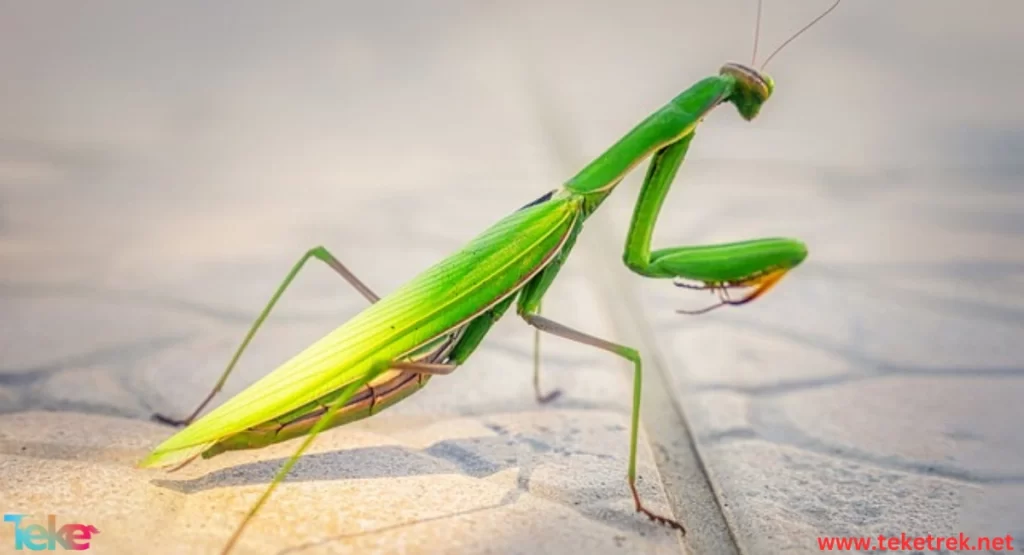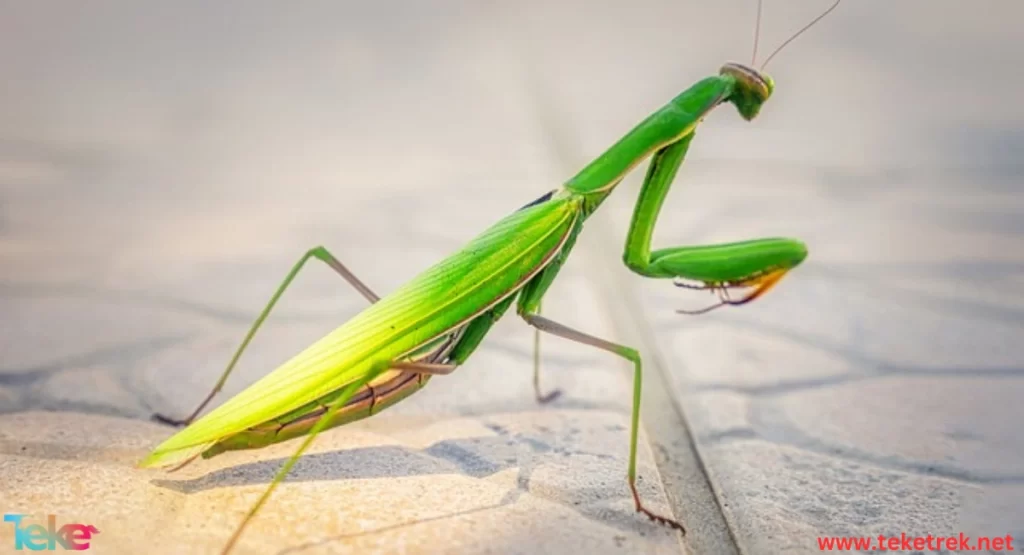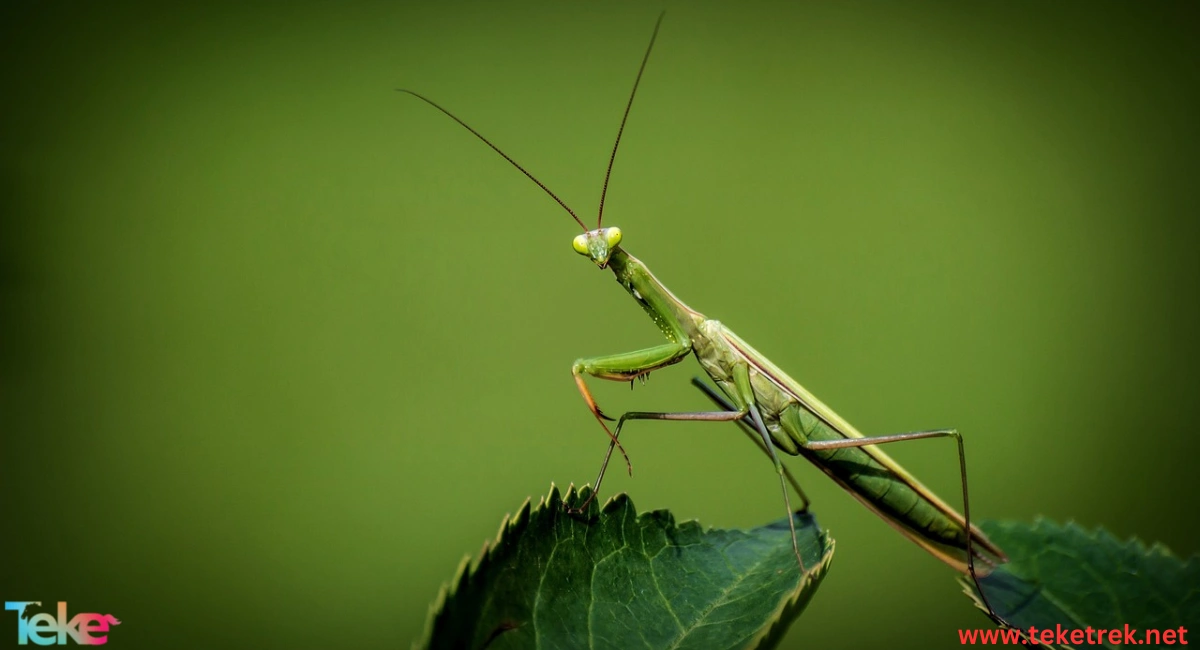Praying mantises are long and slender insects with a unique appearance, featuring large, predatory front legs with long, sharp spikes used for catching prey.
Praying mantises have a long thorax that acts like a neck, allowing the triangular head with large compound eyes to rotate in almost all directions. Continue reading this article on TekeTrek if you want to learn about praying mantises and their lifestyle.
Praying mantises belong to the class Insect, within the phylum Arthropoda.
External appearance of the praying mantis
- Like all insects, praying mantises have a body consisting of three parts: head, thorax, and abdomen. The abdomen is elongated and covered with wings in adults.
- The average length of adult praying mantises generally ranges from 2 to 5 inches, and their color is usually brown, green, or yellow. The color of adult mantises is associated with the habitat they choose during their final molt. Yellow praying mantises ended up among garbage or dry straw, while bright green species remained among fresh grass during their final stage.
- Female praying mantises have large, powerful appendages attached to most of their hindparts. The first part of their thorax is elongated, from which the modified front legs emerge.
- Praying mantises have huge compound eyes mounted on a triangular head, providing them with a wide field of vision.
- These insects use their eyes to detect prey movement and rotate their heads to bring their prey into their microscopic field of vision.
- Praying mantises have a fully articulated head, allowing them to rotate it by 180 degrees.

Places where you can find praying mantises
Praying mantises can be found all over the world with moderate winters and abundant vegetation. They spend most of their time in gardens, forests, or any other vegetated area.
Diet of Praying Mantises
- Praying mantises are carnivorous insects, primarily feeding on other insects such as fruit flies, cockroaches, beetles, as well as mites and bees. Large praying mantises can also consume small reptiles, birds, and even small mammals in order to capture their prey.
- Praying mantises use camouflage to blend into their surroundings, waiting until the prey is within close range, then swiftly using their predatory front legs to snatch the victim. They then use their front legs to assist in positioning the prey for easier consumption.
Life Cycle of Praying Mantises
- Praying mantises undergo three stages of development: egg, nymph, adult, and they have only one life cycle per year. Females lay between twelve to several hundred eggs in a structure called an ootheca.
- These eggs spend the winter in the ootheca and hatch in the spring into tiny versions of the adult, called nymphs. In the nymph stage, these insects consume whatever they can capture as soon as they hatch, then undergo incomplete metamorphosis throughout the growing season, eventually developing wings as they reach adulthood.
- Nymphs and adults generally do not survive through the winter.
- Female praying mantises are generally larger in size than males and have a more robust abdomen.
- It is often believed that female praying mantises eat the male’s head during mating, but this is not always the case and is not necessary for egg production.
- Because praying mantises are ambush predators, they are typically found in vegetative environments where they can blend in. This allows them to wait for prey to arrive before revealing their location.
Reproduction Stages in Praying Mantises
- The mating process in most species of mantises is characterized by cannibalism, where the female consumes the male after mating, a topic of ongoing research.
- Praying mantises begin their lives in an ootheca (typically containing multiple eggs surrounded by a protein foam, which may harden to form a strong protective casing).
- Eggs are usually laid in the autumn on a small branch or twig, then the egg mass hatches in the spring to early summer when rising temperatures indicate the time for birth.
- The natural lifespan of praying mantises in the wild is around 10 to 12 months, but some mantises kept in captivity can last up to 14 months. In colder regions, female mantises die during the winter.
- Male praying mantises tend to die “suddenly” after about 2 to 3 weeks of mating in the autumn.
- This typically occurs due to the female’s desire to kill the male once the egg sac is produced.
Camouflage and Adaptations of the Praying Mantis
The praying mantis can adapt to its environment and camouflage itself to hide from predators. It has a slender body that resembles small tree branches, and its color blends with the surroundings. It can be green, which helps it blend in with trees, or brown, resembling dead wood during the autumn season. This camouflage helps it avoid predators and aids in hunting its prey.
In addition, the praying mantis has several physical characteristics that help it adapt to its environment. It has long legs that allow it to jump quickly, with a jumping power three times stronger than other insects. It also has a sharp spike at the front of its head, which helps it capture prey. The mantis’s legs are flexible and can easily be bent for a rapid strike or escape.
Importance of the Praying Mantis in Pest Control
The praying mantis plays a significant role in biodiversity and pest control. It helps farmers eliminate pests like aphids, mosquitoes, cockroaches, and flies that harm crops and gardens. It also preys on soft-bodied creatures like aphids, mosquitoes, and small larvae, which can cause considerable damage to plants. Therefore, it can be considered a farmer’s friend.
How Do Praying Mantises Communicate?
Praying mantises communicate with each other through body secretions. The female excretes a sticky substance to attract the male for mating. After a mating session that may last up to 40 hours, the female decapitates the male and feeds on his body to replenish lost vitamins. Interestingly, the male remains alive for several days because insects have a decentralized nervous system, meaning they don’t have a real brain in their heads. The male will survive until he is eventually eaten by another animal.
Different Species of Praying Mantises
There are around 15 species of praying mantises. The most well-known is the European Praying Mantis, but other species include:
- African Praying Mantis: This large species is aggressive and can be kept as a pet due to its size and ease of care. It is native to sub-Saharan Africa.
- European Praying Mantis: Native to Europe, this species has spread to North America, where it was imported to control plant pests. It is characterized by its light green color.
- Dead Leaf Mantis: This species resembles dead leaves and can blend into the environment. It has a large size and is difficult to care for, commonly found in Malaysia.
- Ghost Mantis: Known for its strange and distinctive shape, this species looks like tree leaves during autumn. It has a dark brown color and is native to Madagascar and Africa.
- Spotted Mantis: A small species with a distinctive spotted eye, it is commonly found in Gambia, West Africa.
Caring for Praying Mantises in Captivity
Praying mantises are calm and non-aggressive unless provoked. They tend to tolerate humans, making them easy to keep as pets. They can be bred in large quantities for pest control in agricultural fields. They should be kept in well-ventilated boxes or containers made of mesh to allow proper airflow. The container should be securely covered, and it is important to avoid using containers previously exposed to chemicals.
Praying mantises require a diet rich in protein, feeding on insects like cockroaches, crickets, and flies. They may also consume fruit flies. Juvenile mantises are fed daily, while adults can be fed twice a week. It is crucial to offer a varied diet for the mantis’s health. The environment should be cleaned weekly, removing leftover food and maintaining proper humidity.
The health of the praying mantis should be regularly checked, as they may suffer from diseases like losing a limb or having body damage during molting due to low humidity. They can also develop black spots on their eyes or broken wings as a result of mold changes. In some cases, the female mantis may develop an egg sac when there are issues with egg-laying, which can lead to an abdominal rupture.
Defensive Mechanisms of the Praying Mantis
Praying mantises face threats from predators such as frogs, bats, spiders, and birds. To survive, they have developed several defense mechanisms. They have strong legs that can be quickly folded to strike predators. They also possess a sharp spike at the front of their heads, which helps them attack enemies and escape from them. Their powerful legs allow them to jump up to three times their body length, enabling them to quickly flee from threats.
Impact of Climate Change on Praying Mantises
Praying mantises face numerous threats due to climate change. Rising temperatures lead to drought, soil erosion, and the death of trees and plants that mantises depend on. Heavy rains and floods also significantly impact the lives of praying mantises. Additionally, a humid climate can result in parasitic infections, which may cause their death.
Cultural Symbolism of the Praying Mantis
In many cultures, praying mantises are believed to bring good luck. Their majestic appearance evokes spiritual feelings, and they were historically called “praying monks” due to the prayer-like posture of their forelegs, resembling the robes worn by Catholic monks. The mantis is often associated with virtues like courage and perseverance, and it is revered in Buddhist traditions. It is also linked to life and death beliefs in ancient Greek and Egyptian cultures. In Germany, the female mantis is famously known as the “killer” because she eats the male’s head after mating.
How to Get Rid of Praying Mantises
- One of the most effective ways to help control praying mantises is to relocate them by placing them in a container and releasing them elsewhere instead of killing them. Praying mantises help control other insects, making them important for the ecosystem.
- If you’re concerned about handling praying mantises, you can use gloves or tweezers to remove them to another location. Another method to help get rid of them is to allow insectivorous birds, such as bluebirds, swallows, robins, as well as lizards, to nest nearby and feed on praying mantises.


Common Questions About Praying Mantises
- Where does the name “praying mantis” come from?
It was actually named because of its unique stance resembling a praying posture.
- What are the predators of praying mantises?
The main predators of praying mantises are frogs, bats, birds of prey, as well as large birds, spiders, and snakes. Praying mantises may also cannibalize each other, usually during the nymph stage, during mating, and when there are no other prey available.
- What do praying mantises eat?
Praying mantises are ambush predators and will feed on almost anything they can catch. Insects like flies, beetles, moths, and caterpillars, as well as roaches, and even mites and spiders, are part of their diet.
- Can praying mantises fly?
Praying mantises are not strong fliers and are rarely seen in flight. They use their long, slender front legs for jumping and catching prey.
- Do praying mantis bites hurt?
Praying mantises are not aggressive towards humans and generally do not pose a threat. While they are capable of biting if handled roughly or provoked, their bites are rare and typically not harmful to humans. Praying mantises do not have venomous or toxic saliva, so their bites are usually no worse than a minor pinch or scratch. However, it’s always best to handle them gently and with care to avoid any potential bites or injuries.
- Why are praying mantis friendly?
Praying mantises are not inherently “friendly” in the human sense. They are generally calm and non-aggressive unless provoked, but their behavior is driven by instincts rather than friendliness. They may seem tolerant of human presence, but it’s more about their natural disposition and lack of aggression rather than a desire to be friendly.
- Can you touch a mantis?
Praying mantises are not poisonous, but you can use gloves.
In conclusion, praying mantises play an important role in the ecosystem, feeding on soft-bodied insects and aiding in the decomposition of dead plant matter, enhancing their role in the natural nutrient cycle. Praying mantises rely on their surrounding environment and may face challenges due to climate change and habitat loss. To protect praying mantises and preserve biodiversity, measures should be taken to protect their natural habitats and support environmental conservation efforts. Caring for these beautiful insects contributes to maintaining the balance of the ecosystem and the beauty of nature that we enjoy.






